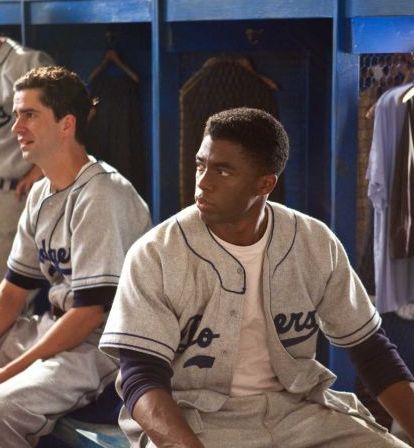It’s not every day that this space leads off with who will be on this week’s “Sports & Torts” show. Then again, it’s not every day that we are able to talk to someone who was directly involved with Jackie Robinson’s debut with the Brooklyn Dodgers.

A studio still from the movie “42” with the actors portraying 1947 Brooklyn Dodgers teammates Ralph Branca and Jackie Robinson.
One of the guests on the April 11 “Sports & Torts” with co-hosts David Spada and Elliott Harris at noon Chicago time on Talkzone.com is former Dodgers pitcher Ralph Branca. Branca probably is best (or worst, if you’re a Dodgers fan) remembered for allowing the game-winning home run to Bobby Thomson in a one-game playoff that put the New York Giants in the 1951 World Series.
Four years earlier — on April 15, 1947 — Robinson broke baseball’s color line. Branca took what was then regarded as the bold move of standing alongside Robinson during pregame ceremonies at Ebbets Field.
In a clubhouse scene from the movie “42” that is to open at theaters on April 12, Branca welcomes Robinson to the Dodgers and extends his hand to his new teammate.
What may seem routine to so many in the 21st century was far from that 66 years ago. And Branca talks about that and more during his more than 40-minute interview that was conducted when he was in Chicago recently for the Chicago Sun-Times Sports Collectibles Convention.
Anyone with a sense of history — baseball and otherwise — ought to check out the show that also will be available later in the day on podcast at Talkzone.com.
For those disinclined to check out the Branca interview, may we recommend the show’s other guest, Jamie Barwick. She is a rookie tight end for the Chicago Bliss of the Legends Football League (previously known as the Lingerie Football League). She talks about the team’s season opener April 19 at the Sears Centre in Hoffman Estates against the Los Angeles Temptation.
Back to baseball, commissioner Bud Selig has announced the On-Field Diversity Task Force. Its goal is to increase African-American representation on baseball rosters.
“As a social institution, Major League Baseball has an enormous social responsibility to provide equal opportunities for all people, both on and off the field,” Selig said in a statement. “I am proud of the work we have done thus far with the RBI program and the MLB Urban Youth Academies, but there is more that we must accomplish. We have seen a number of successful efforts with existing MLB task forces, and I believe we have selected the right people to effectively address the many factors associated with diversity in baseball.”
It seems unlikely baseball will be able to do much to improve the percentage of African-American players in the big leagues (approximately 8.5 percent of opening-day rosters). The percentage was 19 percent in 1995, the Institute for Diversity and Ethics in Sports reports. The percentage in the last decade has been between 8.2 and 10.2 percent.
The difference between 1947 and now is one of opportunity. Robinson opened the gates. The gates remain open. But athletes — of all colors — have more options. Baseball was the king of team sports in 1947 without much competition from basketball or football. Times change.
Of concern to baseball has to be how to attract interest from African-American consumers, regardless of how many African-American ballplayers there are.
Would Jackie Robinson be dismayed to see how few African-American players are following the path that he paved? Perhaps. Then again, if an athlete of Robinson’s abilities were to come along today, he might end up in the NFL or NBA rather than on a baseball diamond.
A preview clip for “42”: